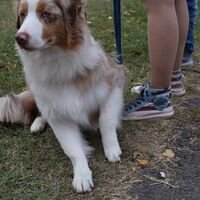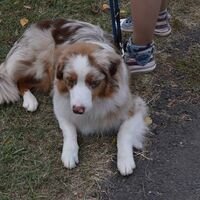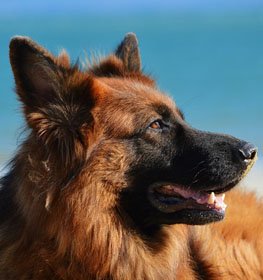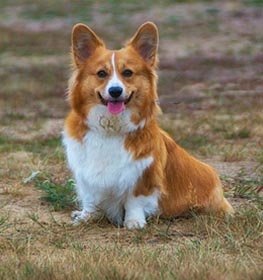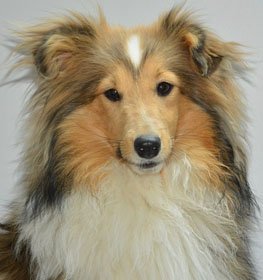Australian Shepherd Information & Dog Breed Facts
Collection of all the general dog breed info about Australian Shepherd so you can get to know the breed more.
| Group | Pastoral / Herding Dogs |
|---|---|
| Popularity Rank | 17 |
| Reviews | 7 |
| User Ratings | |
|
Compare the Australian Shepherd With Other Dogs
Select at least one dog breed to make the comparsion. | |
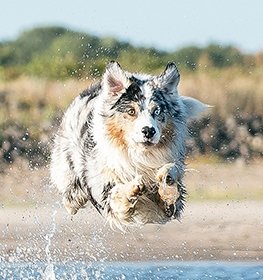 | |
| Origin | |
|
Common Names & Aliases
What other names is an Australian Shepherd known by? Discover all traditional, regional and informal names used for this breed. | Little Blue DogAussie |
|---|---|
|
Breed Classification
What type of dog breed is an Australian Shepherd? Learn about its genetic classification and breeding category. | Purebred The Australian Shepherd is considered a purebred dog breed, but many mixes and hybrids have been created from this breed. We have compiled a list of Australian Shepherd Mixes. |
Photo Gallery of the Australian Shepherd Breed
|
Size Classification
What size category is an Australian Shepherd? Learn how big the Australian Shepherd breed typically grows. | Large |
|---|---|
|
Weight Statistics
How much does an Australian Shepherd weigh? Discover typical weight ranges for adult males and females of the Australian Shepherd breed. | Male: 50-65 pounds (25-29 kg), Female: 40-55 pounds (18-25 kg) |
|
Average Weight
What is the average weight of an Australian Shepherd? | Male: 57.5 pounds (27 kg), Female: 47.5 pounds (21.5 kg) |
|
Height
How tall is the Australian Shepherd? Australian Shepherd height: | Male: 20-23 inches (52-58cm), Female: 18-21 inches (46–53 cm) |
|
Average Height
What is the average height of an Australian Shepherd? | Male: 21.5 inches (55 cm), Female: 19.5 inches (46–53 cm) |
|
Price Range
How much does an Australian Shepherd puppy cost? Find current market prices and factors affecting Australian Shepherd costs. | $600-$800 If you choose to purchase the Australian Shepherd, you should know that the mentioned amount of money is an average of the collected data from breeders’ sites and puppy finder places. If you have a Australian Shepherd for sale, please advertise it on a reliable website to make sure the Australian Shepherd gets to a happy place. |
|---|---|
|
Availability
How easy is it to get a Australian Shepherd? How many Australian Shepherd are there in the world? | Very frequent: The Australian Shepherd is quite easy to get. There is a risk of overbreeding, as it is an extremely popular breed. Inbreeding is common because of its popularity. A new study suggests that inbreeding contributes to the incidence of disease and health problems. So be careful, buy from a trustworthy place or kennel and seek the help of an experienced person, a professional, to make the right decision. |
|
Intelligence Rating
How intelligent is an Australian Shepherd? Discover the Australian Shepherd's intelligence ranking and learning capabilities. | Smart: The Australian Shepherd dogs have great intelligence. They understand and memorize new commands in 15-25 repetitions.
The Australian Shepherd is among the smartest dogs in the intelligence ranking. |
|---|---|
|
Training Difficulty
How easy is it to train an Australian Shepherd? Learn about the Australian Shepherd's trainability and response to training methods. | Australian Shepherd dogs are very easy to train. They easily find out the association between commands and actions. |
|
Watchdog Rating
How good is an Australian Shepherd as a watchdog? Learn about the Australian Shepherd's alertness and guarding instincts. | Australian Shepherd dogs are one of the best watchdogs. Their main job is to observe and they're very consistent in their effort. The best vocal cords and sense of hearing belong to them. Usually, they're very territorial and protective about their property, so the Australian Shepherd dogs will alert you if they sense something different. |
|
Territorial Protection
Is an Australian Shepherd protective of its territory? Learn about the Australian Shepherd's guarding instincts and behavior. | Australian Shepherd dogs are extremely protective guard dogs. This breed doesn't hesitate to protect its territory so the Australian Shepherd can be a good choice if you want an excellent guard dog. Keep calm and the Australian Shepherd will take care of unwanted people or animals. |
|
Personality Traits
What personality does an Australian Shepherd have? Learn about characteristic Australian Shepherd temperament and behavior traits. | ActiveLovingProtectiveIntelligentFriendlyAffectionateGood-natured |
|---|---|
|
Sensitivity Level
How sensitive are they? Australian Shepherd sensitivity: | Sensitive: Australian Shepherd dogs don't like an irregular daily routine, noisy household, and frequent guest visits.
This breed's emotional level reflects their owner's feelings and they don't handle punishments well. |
|
Affection Level
How affectionate are they? Is an Australian Shepherd a good family dog? | Average to High: Australian Shepherd dogs are highly affectionate dogs. They like being involved in the family's life. This breed isn't considered an aloof dog. |
|
Social Needs
How much social interaction does the Little Blue Dog need? Australian Shepherd social needs: | Australian Shepherd dogs are a social breed. They enjoy being around people or other animals. This breed doesn't tolerate being left alone. |
|
Impulse to Wander or Roam
How likely is the Australian Shepherd to run away? Does this breed explore or wander a lot? Does Australian Shepherd roam? | Australian Shepherd dogs are not the biggest explorers. They have low wanderlust potential. Low chance of escaping from home with this breed. |
|
Prey Drive
Do this canine have a strong prey drive? Does Australian Shepherd have high prey drive? | Australian Shepherd dogs have a higher impulse to chase and catch something than other dog breeds. Cats or any other small animals might be in danger. It's a natural instinct, doesn't necessarily mean that Australian Shepherd dogs are aggressive. Better to keep this breed on a leash. |
|
Barking Frequency
Does an Australian Shepherd bark a lot? Learn about typical Australian Shepherd vocalization patterns and triggers. | Low to Average: The Australian Shepherd rarely barks. This breed could be a good choice if you're looking for a quiet breed. They don't bark unless there is a good reason.
Top reasons for barking: protection, alarm, fear, boredom, attention-seeking, greeting, separation anxiety, compulsive barking. |
|---|---|
|
Playful Nature
How playful is an Australian Shepherd? Understand the typical play drive and energy level of the Australian Shepherd breed. | The Australian Shepherd is a highly playful breed. Excited barking and sometimes nipping will alert you to play. |
|
Apartment Adaptability
Can an Australian Shepherd live in an apartment? Learn about the Australian Shepherd's suitability for apartment living. | It is not the best choice if you want to keep them indoors, however, with careful exercise and several walks a day, they will tolerate the indoor environment, so it is possible to keep Australian Shepherd indoors. |
|
Lifestyle Adaptability
How adaptable is an Australian Shepherd to lifestyle changes? Learn about the Australian Shepherd's flexibility to new situations. | Australian Shepherd dogs adapt very well to lifestyle changes and basically all living environments. They don't mind moving from one place to another with their owner. |
|---|---|
|
Alone Time Tolerance
Can an Australian Shepherd be left alone? Learn about the Australian Shepherd's tolerance to solitude. | Australian Shepherd dogs do best when a family member is at home during the day or if their workplace is dog-friendly so they can take the dog at work. |
|
Bite Risk Assessment
What is an Australian Shepherd biting potential? Learn about the Australian Shepherd's bite risk factors. | Low 🔽 The Australian Shepherd has a low chance of biting somebody. Top reasons for dog bite: protection, pain, excitement, herding instinct, being provoked. (Data based on the available online bite statistics.) |
|---|---|
|
Mouthing Tendency
Is an Australian Shepherd mouthy? Learn about the Australian Shepherd's tendency to use mouth during play. | Australian Shepherd dogs have a higher than average tendency to nip, chew, playbite, or herd people. It's a common habit during puppyhood, not aggressive behavior. These "bites" don't hurt, but Australian Shepherd dogs need to be taught a good attitude. |
|
Bite Strength Rating
How strong is an Australian Shepherd bite? Learn about the Australian Shepherd's bite force measured in PSI. | Between 200 and 400 PSI ⏺ Australian Shepherd bite force: Ordinary. Bite force Australian Shepherd measurements typically fall within the range of 200 to 400 PSI. The bite force of an Australian Shepherd is considered ordinary when compared to other dog breeds, but it is still quite powerful. This Australian Shepherd bite force PSI can cause bite wounds. Australian Shepherd bite PSI is not something that should be feared if the dog is well-trained and managed. To avoid any issues, it's essential to learn how to train an Australian Shepherd puppy not to bite from an early age.
The Australian Shepherd, and many others, have a fearsome presence because they have significant jaw strength, so it is important not to anger the dog and have it around strangers until it is fully trained. However, they are usually quite calm and good companions, they work well in families and are easy to care for. In conclusion, while the Australian Shepherd bite force is certainly an interesting aspect of the breed, it is important not to let it overshadow the many other reasons why these dogs are so loved and respected. With proper training and socialization, an Australian Shepherd can be a loyal and protective companion for your family. |
|
Average Lifespan
How long does an Australian Shepherd live? Learn about the typical lifespan of the Australian Shepherd breed. | 11-15 years The average lifespan of Australian Shepherd: 13 years |
|---|---|
|
Climate Tolerance
How well does an Australian Shepherd handle different weather? Learn about the Australian Shepherd's climate adaptability. | Prefers average to cold weather conditions The Australian Shepherd can adapt to well to cold weather conditions, some dogs even can be a good mountain dog. |
|
Health Concerns
What health issues are common in an Australian Shepherd? Discover typical conditions affecting the Australian Shepherd breed. | The Australian Shepherd is a healthy breed, but there are certain health issues that you should check with your vet regularly. |
|
Vet Care Frequency
How often does an Australian Shepherd need vet visits? Learn about the Australian Shepherd's veterinary care requirements. | Average The Australian Shepherd should have a complete physical check-up at least once per year. If your dog shows any symptoms, call your veterinarian. |
|
Health Problems
What genetic/health problems does the Australian Shepherd breed have? What are the health issues and concerns of the Australian Shepherd breed? Most common health risks of Australian Shepherd: | Cataracts Hip Dysplasia AllergiesCancerHypothyroidismProgressive retinal atrophy (PRA)EpilepsyDeafnessDrug SensitivityElbow DysplasiaDistichiasisCollie Eye AnomalyDetached RetinaNasal Solar DermatitisOsteochondrosis DissecansPersistent Pupillary Membranes |
|
Energy Rating
How energetic is an Australian Shepherd? Understand daily activity needs of the Australian Shepherd breed. | Australian Shepherd dogs are high-energy dogs. An active lifestyle makes them happy. |
|---|---|
|
Activity Requirement / Exercise Need
How much exercise does an Australian Shepherd need? How much exercise do Australian Shepherd dogs require per day?
Do Australian Shepherd dogs need a lot of exercises? | Australian Shepherd dogs need a lot of exercises. Long walks should be on a daily schedule. If you live an active life, this breed can be a good choice for you. |
|
Sleeping Need
How much sleep does the Australian Shepherd breed need? | Australian Shepherd dogs don't need too much sleep. They are energetic and desire to live active life. If you think naps are overrated, this breed can be the best choice for you. |
|
Obesity Tendency
Is an Australian Shepherd prone to weight gain? Learn about the Australian Shepherd's obesity risks. | Average to High: If you don't pay attention to the Australian Shepherd's weight, he can easily gain weight. More than one daily walk should be on schedule. To make your dog happy and fit, feed him with quality dry dog food and live an active life together. Try to find the happy medium between exercise and feeding.
If you notice any weight gain, consult your veterinarian and make a diet plan. Reduce unhealthy food and snacks, and measure the Australian Shepherd weight regularly. |
|---|---|
|
Food Consumption
How much food does an Australian Shepherd need daily? Learn about the Australian Shepherd's feeding requirements. | 1.5 to 2.5 cups of high-quality dry food a day, divided into two meals. |
|
Allergy Friendliness
Is an Australian Shepherd hypoallergenic? Learn about the Australian Shepherd's suitability for allergy sufferers. | No Australian Shepherd dogs don't do well with allergy sufferers by causing allergic reactions. Some dog breeds are even considered to higher possibility of an allergic response. Coat type isn't necessarily relevant, because most people are allergic to dander (flakes on the dog's skin) or saliva, not actually to dog hair. |
|---|---|
|
Coat Colors
What colors does an Australian Shepherd come in? Discover all possible Australian Shepherd color variations. | Black Red Blue Merle |
|
Grooming Requirements
How much grooming does an Australian Shepherd need? Learn about Australian Shepherd coat maintenance requirements. | Average: The Australian Shepherd requires average grooming effort. Cutting the dog's hair by a professional groomer isn't essential. Brushing the dog's coat is useful to reduce shedding. Ears and eyes should be cleaned regularly to avoid infections. Don't skip the seasonal flea treatment too. Dog nail trimming and dog bath can be helpful sometimes. Check the local pet store for dog grooming supplies and find the best dog shampoo to keep its coat healthy and give your dog a pleasant experience of a dog bath. If you don't have the time, skill, or money to take care of your Australian Shepherd, search for a dog groomer or clipping service in your area and book an appointment. Maybe you're lucky to have a dog boarding service that includes grooming or walk-in dog bath places nearby. |
|
Drooling Tendency
Does an Australian Shepherd drool a lot? Learn about the Australian Shepherd's drooling habits. | The Australian Shepherd is a perfect example of a very low drooling tendency. If you're disgusted by slobber spots on your clothes, the Australian Shepherd could be a perfect choice for you. Drooling is the unintentional saliva flowing outside of the mouth. It can be completely normal or a sign of a health problem. Certain dog breeds drool minimum compared to others, just like the Australian Shepherd.
If you notice any change in your dog's drooling habit, you should contact a vet as soon as possible. |
|
Stinkiness Rating
Does an Australian Shepherd smell bad? Learn about the Australian Shepherd's natural odor levels. | Medium ⏺ The Australian Shepherd has an average chance of bad smell. Top reasons for dog stinkiness: infection of bad tooth/ear/skin folds, gas attacks. |
|
Coat Characteristics
What type of coat does an Australian Shepherd have? Learn about the Australian Shepherd's fur characteristics. | Feathered |
|
Bathing Needs
How often does an Australian Shepherd need baths? Learn about the Australian Shepherd's bathing requirements. | 6-8 weeks Rarely. Bathing your dog is beneficial to them in more ways than just one. It’s also a good time to look for unusual scratches, bumps, fleas, and other irregularities. When their hair is wet and flat against their body, these details are more visible.
For example, short-haired dog breeds can go a very long time in between baths. These short-haired breeds shed regularly and that shedding works to naturally remove excess dirt and oil. So unless your weenie dog got into the garbage can, you can probably hold off on a bath for a while. |
|
Shedding Level
How much do Australian Shepherd dogs shed? How to control, reduce and prevent the shedding of the Little Blue Dog? Do Australian Shepherd dogs shed a lot? | Australian Shepherd dogs shed moderately. It's a natural process of the hair growth cycle. Regular brushing reduces the amount of hair that sheds. It mostly depends on their health status and breed type. |
|
Child Compatibility
Is an Australian Shepherd good with children? Learn about the Australian Shepherd's behavior around kids of different ages. | Australian Shepherd dogs are very kid-friendly dogs. This breed enjoys being surrounded by children.
|
|---|---|
|
Pet Compatibility
How well does an Australian Shepherd get along with other pets? Discover the Australian Shepherd's compatibility with other animals. | Australian Shepherd dogs are generally with other pets. |
|
Stranger Friendly
Are they aggressive or friendly towards/with strangers? Australian Shepherd temperament with other people: | Australian Shepherd dogs are not the most stranger-friendly dogs. |
|
Cat Friendly
How well do Australian Shepherd dogs get along with cats? Are they good with kittens? What is this fido's temperament with cats? Can they be good with cats? Can the Australian Shepherd breed live with a cat? | Australian Shepherd dogs are average friendly towards cats. |
|
Dog Friendly
Is Australian Shepherd good with other dogs? Are they dog-friendly dogs? How well do Australian Shepherd dogs get along with other dogs? | Australian Shepherd dogs are average friendly towards other dogs. |
|
Good For First Time Owners
Is Australian Shepherd breed good for first-time owners? Do they make a good dog for novice owners? Is Australian Shepherd breed suitable for first-time owners? | Yes Australian Shepherd dogs are good for novice owners, due to their easy-going personality. |
|
Office Friendly
Are Australian Shepherd dogs good office canines? Do Australian Shepherd dogs make good office-friendly pets? Can they be office dogs? | No Australian Shepherd is not the best dog breed for office environment. |
|
Senior Citizens Friendly
Are they senior citizens friendly dogs? How well do Australian Shepherd dogs get along with the elderly people? What is the Little Blue Dog temperament with senior people? Are Australian Shepherd dogs good for elderly owners? | Australian Shepherds are one of the best breeds for elderly people. |
|
Service Dog Capability
Can an Australian Shepherd be a service dog? Learn about the Australian Shepherd's service work potential. | Not really This breed generally not used as a service dog. A service dog is a term used in the USA to refer to any type of assistance dog specifically trained to help people who have disabilities, such as visual impairment, hearing impairments, mental disorders, seizures, mobility impairment, and diabetes. Service dogs are protected under the ADA (Americans with Disabilities Act).
Australian Shepherd is not the best breed for service purposes. |
|---|---|
|
Therapy Work Suitability
Is an Australian Shepherd good as a therapy dog? Learn about the Australian Shepherd's therapy work aptitude. | Not really This breed is generally not used as a therapy dog. A therapy dog is a dog that might be trained to provide affection, comfort, and love to people in hospitals, retirement homes, nursing homes, schools, hospices, disaster areas, and people with anxiety disorders or autism.
Australian Shepherd is not the best breed for therapeutic purposes. |
|
Scent Detection Ability
Is an Australian Shepherd good at detection work? Learn about the Australian Shepherd's scenting abilities. | Not really They are not typically employed for this type of work, but there may be exceptional cases. A detection dog or sniffer dog is a dog that is trained to use its senses (mostly its smell) to detect substances such as explosives, illegal drugs, wildlife scat, currency, blood, and contraband electronics such as illicit mobile phones.
Australian Shepherd is not the best breed for detection purposes. |
|
Search & Rescue Potential
Can an Australian Shepherd do search and rescue? Learn about the Australian Shepherd's SAR capabilities. | Not really This dog breed is not typically used as a search and rescue dog. The use of dogs in search and rescue (SAR) is a valuable component in wilderness tracking, natural disasters, mass casualty events, and locating missing people.
The Australian Shepherd is not the best breed for SAR purposes. |
|
Maritime Work Ability
Is an Australian Shepherd good on boats? Learn about the Australian Shepherd's maritime capabilities. | Not really Australian Shepherd breed usually doesn't like being on a boat. Boat dogs were typically bred for their strength, stamina, and water resistance, as they were often required to perform tasks such as pulling in fishing nets, and jumping into the water to retrieve ropes or lines, or helping to move cargo. Sailor dog is a type of dog that was bred to accompany sailors on their voyages. They were typically used for three purposes: as a working dog, a watchdog, and as a companion. A boat dog is a term used to describe a type of dog that was traditionally bred and used as a working dog on boats. |
|
Draft Work Capability
Can an Australian Shepherd pull carts? Learn about the Australian Shepherd's drafting abilities. | Not really A drafting dog or draft dog is a dog bred and used for cart pulling. Dogs bred for this work have strong builds and qualities that are needed, strength and determination.
Australian Shepherd is not the best breed for drafting purposes. |
|
Military Service Background
Was an Australian Shepherd used in military service? Learn about the Australian Shepherd's military history. | Not really In history, this breed was not really used for combat dog. |
|
Puppy Litter Size
How many puppies does an Australian Shepherd usually have? Learn about typical litter sizes. | 6-9 puppies, average 7 |
|---|---|
|
Pregnancy Duration
How long is an Australian Shepherd pregnant? Learn about the Australian Shepherd's gestation period. | 60-64 days Reproductive cycle of the female Australian Shepherd: The first period called Proestrus lasts for about 9 days.
During this time the females start to attract males. You can notice by swelling vulva and bloody discharge. The second part is the Estrus when the female is receptive for the male. It lasts for about 3 to 11 days. The sign of the proestrus part is the soft and enlarged vulva. The discharge decreases and lightens in color. The third part is the Diestrus. Normally, it occurs around day 14. In this period the female’s discharge changes for vivid red and coming to its end. The vulva returns to average, and she will no longer permit mating. The fourth part called the Anestrus. The time frame between heat periods normally lasts about six months. |
|
Breeding Frequency
How often can an Australian Shepherd have puppies? Learn about safe breeding intervals. | Once a year. More frequent breeding is not healthy. It is very important not to buy a dog from a puppy mill, where the needs of the pups and their mothers are ignored. It's an inhumane high-volume dog breeding facility, where puppies born several times a year. |
|
AKC Classification
What AKC group is an Australian Shepherd in? Learn about the Australian Shepherd's AKC classification. | Recognized by the American Kennel Club in 1991 as a Herding breed. |
|---|---|
|
FCI Classification
What FCI group is an Australian Shepherd in? Learn about the Australian Shepherd's international classification. | Recognized by FCI in the Sheepdogs and Cattledogs (except Swiss Cattledogs) group, in the Sheepdogs section. |
|
Kennel Club Recognition
Which kennel clubs recognize an Australian Shepherd? Learn about the Australian Shepherd's official recognition. | American Canine RegistryAmerican Kennel ClubAmerica's Pet RegistryDog Registry of America Inc.North American Purebred Registry, Inc.American Canine Association, Inc.Continental Kennel ClubNational Kennel ClubNew Zealand Kennel ClubUnited Kennel ClubAustralian Shepherd Club Of America |
Australian Shepherd Pros and Cons
- Intelligence Rating: Smart: The Australian Shepherd dogs have great intelligence.
- Training Difficulty: Australian Shepherd dogs are very easy to train.
- Drooling Tendency: The Australian Shepherd is a perfect example of a very low drooling tendency.
- Watchdog Rating: Australian Shepherd dogs are one of the best watchdogs.
- Impulse to Wander or Roam: Australian Shepherd dogs are not the biggest explorers.
- Lifestyle Adaptability: Australian Shepherd dogs adapt very well to lifestyle changes and basically all living environments.
- Child Compatibility: Australian Shepherd dogs are very kid-friendly dogs.
- Senior Citizens Friendly: Australian Shepherds are one of the best breeds for elderly people.
- Good For First Time Owners: Australian Shepherd dogs are good for novice owners, due to their easy-going personality.
- Allergy Friendliness: Australian Shepherd dogs don't do well with allergy sufferers by causing allergic reactions.
- Obesity Tendency: Average to High: If you don't pay attention to the Australian Shepherd's weight, he can easily gain weight.
- Mouthing Tendency: Australian Shepherd dogs have a higher than average tendency to nip, chew, playbite, or herd people.
- Alone Time Tolerance: Australian Shepherd dogs do best when a family member is at home during the day or if their workplace is dog-friendly so they can take the dog at work.
- Office Friendly: Australian Shepherd is not the best dog breed for office environment.
Australian Shepherd History
The Australian Shepherd, contrary to popular belief, is not indigenous in Australia. The breed finds its origins in the United States of America dating back to the early 1800s. The breed is thought to be developed first in the State of Colorado around the time of the Gold Rush.
There are many existing theories about the breed’s exact breeding process. The most likely is that the Australian Shepherd is descended from a long line of European herding breeds, brought to the United States by immigrants. It is widely believed that the Collie, the Border Collie, the Pyrenean Shepherd, and other shepherd types of dogs contributed to the Aussie’s early development. During the 1840s, there were many Australian shipments arriving in the United States, bringing flocks of sheep. The ranchers and farmers working with these sheep saw the abilities of the Aussie and started to put more emphasis on enhancing their herding ability. Consequently, this is where the breed got its name after. The Aussies were developed surrounded by harsh climate conditions, which changed frequently and by high altitudes of the Rocky Mountains, which made the dogs very athletic. The breed has always been a well-esteemed and favored farm dog, in the central parts of the United States, for their obedience and extraordinary herding capabilities which applied to a wide range of livestock. The Aussie’s innate intelligence to herd sheep, cattle, and farmed rabbits with equal efficiency and skill.
The Australian Shepherd gained immense popularity among both the farmers and ranchers, but among others too. They enjoyed their popularity boom during the Second World War, which went hand-in-hand with a renewed interest in Western-style horseback riding. The dogs were showcased on rodeo and horse shows where the audiences of western movies and TV shows were astonished by the breed’s athletic yet elegant physical appearance. Moreover, the crowds were wowed by the Aussie’s remarkable intelligence, and by the way how smoothly the dogs could work alongside the farmers and the horses. After their well-established working role and its popularity in the entertainment industry from rodeos and riding appearances in Hollywood blockbusters, the breed got in the eye of the general public. Thanks to the breed’s appearance on the screen, many famous people got Australian Shepherds as pets, including Stephen Spielberg, who became fond of the breed, after working with one in a film.
Despite the huge public interest, the major kennel clubs registered this pure-bred breed relatively late, in the 1990s. The AKC (American Kennel Club) only recognized the Australian shepherd in 1993 in their Herding Group. Nowadays, the breed is still very popular, it is currently ranking 16th among the AKC members. The Aussie’s work today mostly concludes agility, hiking and simply being a family companion. Nevertheless, thanks to the breed’s versatile nature, and intelligence, many Australian Shepherds are being employed as drug detectors, therapy dogs for children and the elderly, rescue dogs, service dogs, search-and-rescue dogs.
Latest Australian Shepherd Compares
Featured Australian Shepherd Compares
Australian Shepherd Names
How old is my Australian Shepherd in human years?
You May Also Like
Rate The Australian Shepherd Breed
Australian Shepherd Comments, Reviews and Questions
- Lori
Dec 28, 2022, 10:00:36 AM:
Loved my Buster, Black Tri and now Dan also Black Tri! HIGHLY INTELLIGENT, LOVING, SENSITIVE! Natural herder. Watches my Husband, who’s diabetic & unstable with gait. Loves visiting family & truck rides.
- luna
Sep 26, 2022, 11:44:01 PM:
this dog breed is so cool the history is ingesting this breed is kid loving and that makes it so awesome
- Nia
Feb 25, 2022, 6:51:44 AM:
- Selena
Jan 19, 2022, 9:32:15 PM:
- Sydney
Jul 16, 2021, 9:14:49 PM:
Excellent multi-purpose friend. Loyal, and a real character! Sometimes bossy with other animals, but never mean.
- xc v<s
Apr 18, 2019, 5:42:31 AM:


